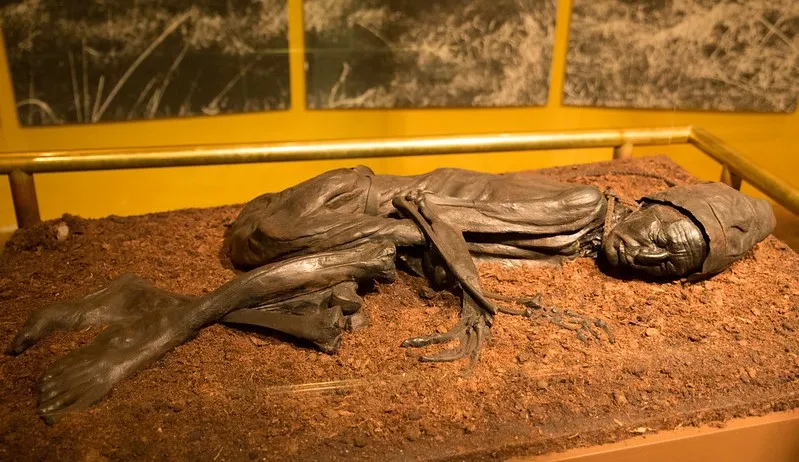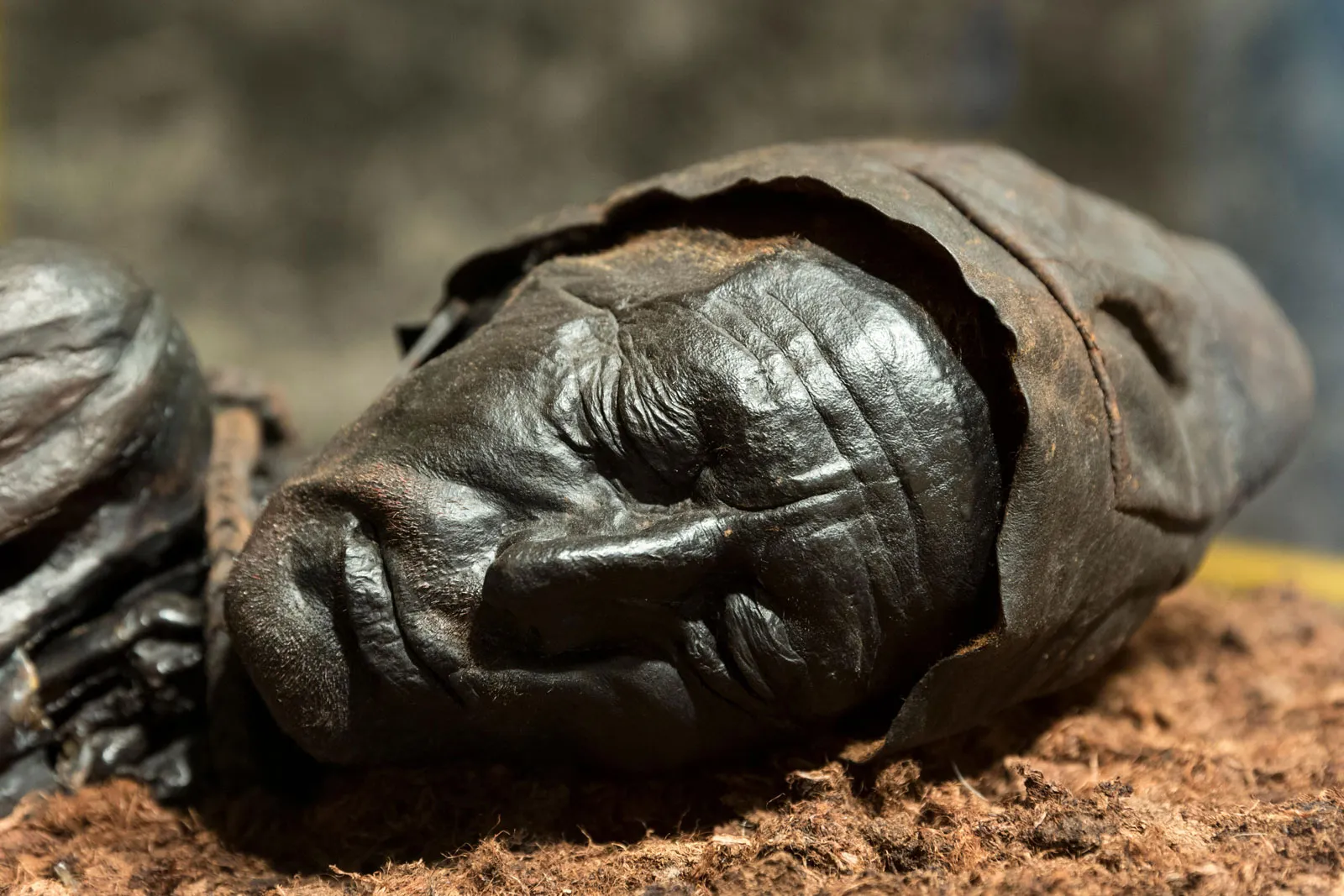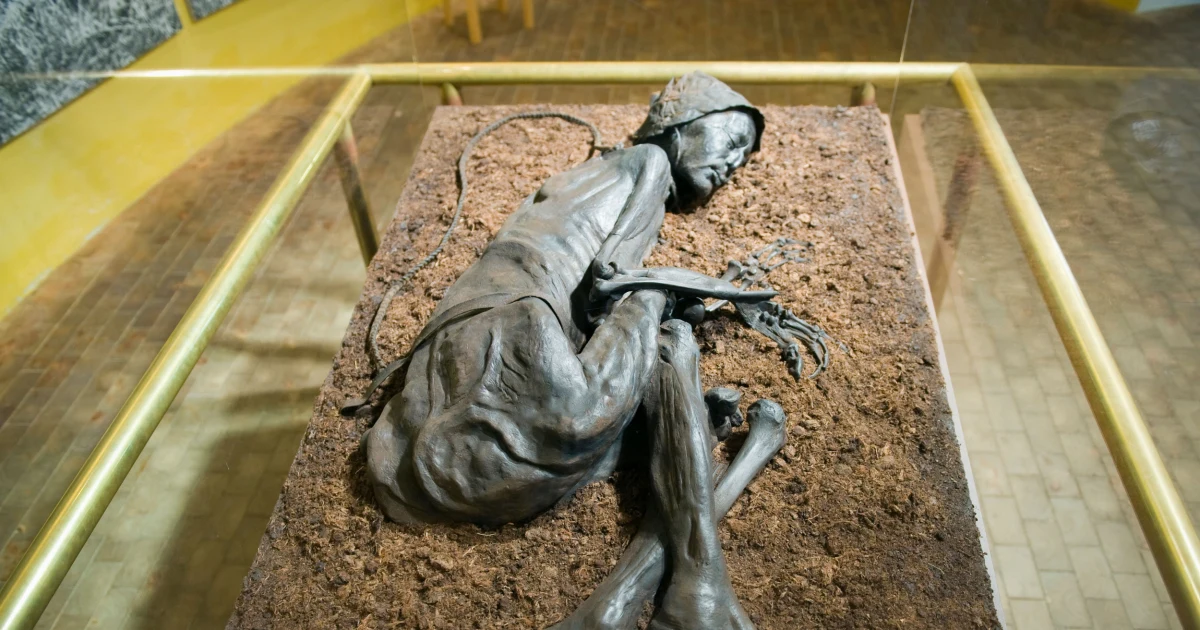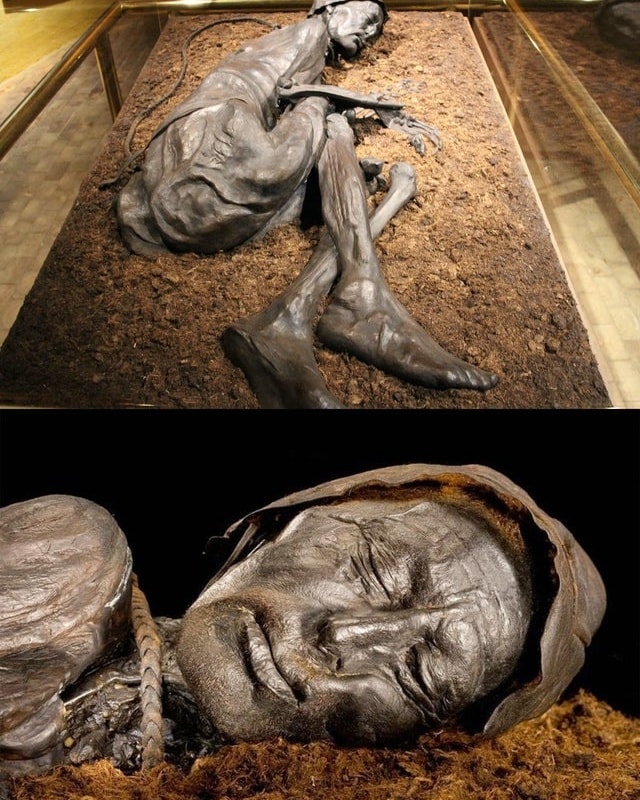The “Tollund man” is a 2400-year-old bog body and victim of human sacrifice from the Iron Age, found in Bjældskovdal in Denmark. His body was so well-preserved that even after 2400 years scientists were still able to take his fingerprints and determine what he had eaten last.
When a family cutting peat for fuel unearthed a mysterious body in a Danish bog in 1950, they assumed the well-preserved corpse was a local murderer’s latest victim. In fact, he was anything but: Although the man had been killed, his body dated from the Iron Age, about 2,400 years ago.

Now known only as the Tollund Man, his incredibly preserved face, stubbled and slightly smiling, has ensured him a place as one of the world’s most famous bog bodies—made even more mysterious by the fact he was the assumed victim of human sacrifice.
In the decades since his discovery, scientists have studied Tollund Man extensively and pieced together more details about his life and death. Here’s what to know about the naturally mummified man.
Who was Tollund Man?
A brown, bronze-like mummified body of a man laying on his side in the fetal position on a square pile of brown earth and soil, with a braided rope around his neck against a black background.
Although scientists know that Tollund Man died of hanging, they’re not yet sure why. Could he have been killed in…

The presence of wisdom teeth suggests the Tollund Man was at least 20 years old when he died in Denmark’s Bjældskovdal bog in Jutland, but researchers think he was actually between 30 and 40. Radiocarbon dating indicates he died at some point between 405 and 380 B.C.
Standing at about 5 foot 3 inches, the Tollund Man was discovered in a sleeping position with a rope around his neck. An autopsy revealed he had died of hanging, noting his extremely well-preserved head and face.
After his death, the acidity in the peat bog preserved Tollund Man’s bones and many of his soft tissues, including an intact yet shrunken brain and intestines complete with their contents. Tollund Man’s skin and nails had cured and blackened over thousands of years spent in the oxygen-free environment of the bog. But their full decomposition was blocked by the chemicals that are produced when sphagnum moss, the main moss that comprises peat, degrades.
Today, his body is preserved at the Silkeborg Museum, a Danish cultural heritage museum near the place of his discovery.
Who were his people?
Tollund Man lived during the early part of the Iron Age in the years before Rome conquered the majority of Europe. During the period, Jutland was well populated and home to villages and farms. The era’s farmers grew grain, kept animals, and engaged in religious rituals that involved leaving sacrifices—often food or weapons, but sometimes human bodies—in the local bogs.

Modern-day researchers suspect these bogs were seen as supernatural sites with connections to the gods and the afterlife. But since the Jutland dwellers left no writing behind, it’s unclear what actually drove their religious rituals.
What he wore
Bogs are famous for preserving clothing along with bodies, like the knitted clothing that surrounded a Scottish bog body found in 1951. But Tollund Man wore much less apparel: He was buried naked, clad only in a cap and belt.
Further investigations have revealed that Tollund Man likely wore shoes for part of the year, but also walked barefoot much of the time. Stubble on his face indicates he must have shaved.
His last meal
In 2021, researchers discovered the contents of Tollund Man’s last meal—porridge containing barley, a variety of wild seeds, flax, and fish. The gut analysis also revealed that unlike some other famous bog bodies, Tollund Man wasn’t under the influence of edible hallucinogens or other medicinal plants when he died—signs that typically indicate a human sacrifice.
His death
But scientists say Tollund Man could have been the victim of a ritual sacrifice. The wide variety of types of seeds and weeds found in his gut are similar to those discovered in the digestive tracts of other bog bodies thought to have been sacrificed. “People have suggested that they’re forming a human sacrifice because something’s going wrong in the environment,” archaeologist Henry Chapman said of those victims in a 2021 interview with National Geographic. Those cases have led researchers to believe that the sacrifices involved eating a wide variety of types of food before death, perhaps in response to environmental changes that threatened farming or food sources.
Another possibility is that Tollund Man’s death could have been more sinister: Perhaps he was a criminal, died by suicide, or was part of a vengeance killing thought to have been a practice in northern Europe at the time. Other bog bodies found throughout the region show evidence of purposeful killing and even gruesome abuses of the corpses. But though he was clearly killed on purpose, Tollund Man’s body was also carefully buried, and his mouth and eyes closed. Ultimately, that careful burial, his hanging, and the fact that cremation and grave burials were more common at the time than throwing bodies into bogs is why many researchers believe his death was part of some kind of sacred sacrifice.
His remaining mysteries Though it’s been nearly 75 years since his discovery, Tollund Man could continue to yield more information to curious archaeologists. During scientists’ initial experiments with the bog body, his head was carefully preserved and was put on display in Denmark. But his body dried out and was misplaced—yes, misplaced.
For decades no one knew where the bog body’s limbs and organs were. This led to a bizarre treasure hunt in the 1980s when researchers, armed with new technologies, realized the potential worth of the rest of the body and asked for the public’s help locating the remainder of the corpse.




